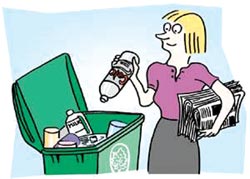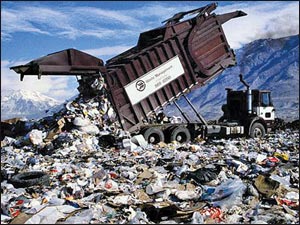Zero waste
Robin Murray
Waste is the shadow side of the economy. Stripped of desire, it
weighs like a corpse around the necks of the living. It is placed in
black bags and transported, like the dead, to sites of exclusion - to
landfills and incinerators, the graveyards and crematoria in the kingdom
of objects.
|

Recycling all plastic bottles |
From the perspective of policy, waste has first and foremost been
seen as an issue of public health, something that needs to be removed
from society as quickly and cheaply as possible. What has developed in
response is a system of mass disposal, where household rubbish is
collected and disposed of as a single stream of mixed waste. Scale and
speed have been everything. Mass production has generated as its
counterpart mass waste.
Mass waste
Mass waste is not simply the discards of mass consumption. It also
comprises the waste generated at each phase of production, in mines or
fields, in factories and shops, all of which far exceed consumer waste.
In England, “producers” account for 91% of national waste.
With food, for every kilo we eat, ten kilos of waste is generated
along the food chain. For consumer goods the trail of waste can be much
greater. A car that weighs a tonne takes seventy tonnes of material to
produce. Waste is the leviathan of the modern industrial system.
Over the past thirty years there has been a growing recognition that
this system of extensive exploitation of the material world cannot be
sustained. It is not just a question of the profligate use of materials:
it is also the energy it takes to process the materials, and the ever
mounting problem of disposal.
In many countries the trigger for change has been political - the
opposition by local communities to extraction and logging at one end of
the chain, and to new landfills and incinerators at the other.
But what started as primarily a movement of resistance has turned
into a movement of alternatives.
The case is highlighted by organic waste. In England, we throw away a
third of all the food we buy. In the pre-modern period much of this
would have been composted or given to pigs and chickens. But urbanism
and food regulation broke this cycle and resulted in a double loss. Not
only did the land lose a major source of nutrients, but food waste was
concentrated in landfills where, coupled with garden and other organic
waste, it became a significant contributor to climate change.
|

A truck dumping garbage |
However, as evidence grew about soil degradation and erosion, the
environmental impact of artificial fertilisers, and the potential role
of compost-improved soils for the prevention of flooding and for the
sequestration of carbon, the pressure rose to restore the biological
cycle. In the UK, a community composting movement grew up.
Municipalities encouraged home composting and introduced “green”
collections. By 2003, 2 million tonnes of organic waste were being
composted at 325 facilities nationwide.
Industrial composting systems are now well established in the
Netherlands and Germany.
But the most striking model has been developed in Italy.
Municipalities found that making a separate collection of food waste
from households and restaurants and encouraging home composting meant
that they could both create marketable compost and keep organic waste
out of mainstream disposal. Instead of the big black plastic bag, they
introduced small, transparent, biodegradable bags, which could be
collected by small electric vehicles and composted close by. A local
biological cycle was restored.
Visibility is everything
In the Italian model, food waste was made separate and visible.
Visibility is everything if food waste is to be transformed into a
useful material. The same holds true for other waste. The moment waste
is removed from the dustbin into the light, it becomes clear that, like
food, much of what had been discarded as waste is potentially a source
of value: recyclers in cities now refer to waste as “urban mines”.
Grey energy
More than that, much so-called waste embodied what is called “grey
energy” - the energy used in every stage of production. By the early
1990s, the five leading non-food materials in the Western domestic waste
stream - paper, cardboard, steel, aluminium and glass - were found to
account for two-thirds of industrial electricity use in the US. Rescuing
these materials from disposal has meant that the energy needed to
manufacture from virgin materials is no longer required.
So, alongside the restoration of biological cycles, there has been a
parallel move to restore material cycles, thereby preserving the value
of the materials, the energy, and the work embodied in the discarded
commodities. It is a question not just of recycling, but of “upcycling”:
finding ways in which the qualities of the discards can provide more
valuable inputs in their next life (crushed bottles as water filters,
for example, or old tyres into basketball court surfaces). As with food,
the perspective involves a shift from the linear model of mass waste to
a circular model that conserves value and resources.
The critique of traditional waste systems and the development of
alternatives has been led by community and environmental movements.
Third World
Network Features |



